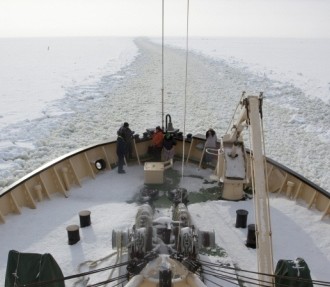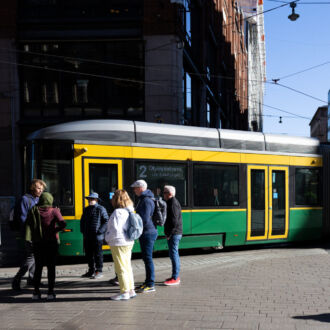About 80 percent of world trade in goods occurs by sea, but 98.8 percent of ships still use fossil fuels, according to UN Trade and Development. This means that it is critical to make this important industry more sustainable if we are to fulfil net-zero goals.
The young Finnish company Norsepower develops sails. These aren’t the type of sails you see on sailboats, however.
They manufacture rotor sails, tall rotating columns that make use of the Magnus Effect. That’s the same force that allows soccer players to kick a ball and make it curve through the air.
Electric motors make the rotors spin. When wind hits the rotors from the side, a force is generated in front, helping to push the ship along. The forward thrust should far exceed the energy required to spin the rotors.
“Cargo vessels are our main market,” says Jarkko Väinämö, COO of Norsepower. “We have also installed our sails on passenger ships. We can install them on the deck of an old ship, but they work better on vessels which have hulls designed specifically for wind power.”
Reducing costs and emissions

The Chinook Oldendorff, a ship capable of carrying more than 100,000 tonnes, is fitted with three rotor sails from Norsepower.Photo: Norsepower
As with traditional cloth sails, the performance of rotor sails depends upon wind conditions and proper handling of the equipment. Normally, rotor sails complement existing engines, yet when conditions are perfect, rotor sails alone can propel a ship.
“Typically, rotor sails reduce fuel use and emissions by five to 20 percent,” Väinämö says. “We are working on an Airbus transport ship which will have six sails and an expected savings of 50 percent. Recently, we had a French ship of 50,000 deadweight tonnes sail at eight knots using only two rotor sails.”
Lowering fuel use lowers costs, making rotor sails a compelling business case for ship owners. Stricter regulations like the FuelEU Maritime Directive are also driving demand for cleaner solutions.
“We believe 20,000 vessels around the world could benefit from rotor sails,” says Väinämö. “This is a potential 60-billion-euro industry.”
Smooth sailing with batteries

A Wärtsilä employee works on the production floor at the company’s Sustainable Technology Hub in Vaasa on the Finnish west coast.Photo: Wärtsilä
Engines in passenger cars evolved from using fossil fuels to being hybrids to finally being fully electric. The same process is happening in shipping, and the Finnish company Wärtsilä is at the centre of the revolution. Founded in 1834, Wärtsilä focuses on the energy and maritime industries.
“The uptake of this technology is exponential,” says Torsten Büssow, director of the electrical and power systems business at Wärtsilä Marine. “We have already delivered over 100 battery-powered ships.”
While rotor sails work best in the sustained winds of mid-ocean journeys, batteries are popular among the variety of ships plying coastal waters and shorter routes. These include cruise ships, car ferries, cargo vessels and harbour workboats. A growing category for electrification is Ropax vessels, which are combined passenger ships and vehicle ferries. These are commonly seen on the routes between Helsinki and Stockholm, Sweden or Tallinn, Estonia.
“We recently worked with Finnlines on a new Ropax vessel with a hybrid power system and 5 megawatts of energy storage,” Büssow says. “They could use electric to manoeuvre in a harbour or when they are within sight of land, for example, and regular engines when they are out to sea.”
How to be net-zero by 2050

The largest electric ship in the world, a new 130-metre-long fast ferry for a route between Argentina and Uruguay, contains a battery electric propulsion system and waterjets from Wärtsilä.Photo: Incat Tasmania/Wärtsilä
The end goal, of course, is not to merely reduce CO2 emissions, but to eliminate them entirely. This is possible with fully electric vessels, if the batteries are charged with electricity generated from renewable sources like wind, solar and hydro. Wärtsilä has already delivered its electric propulsion system for several fully electric vessels, and is currently working on a 130-metre-long fast ferry that will operate between Argentina and Uruguay. It will be the largest electric ship in the world, powered by 40 megawatts of batteries.
There are other ways for ships to run emission-free, such as using biofuels or synthetic fuels. Büssow thinks a mix of fuels and technologies will make the maritime industry sustainable, not a one-size-fits-all invention. But we are running out of time.
“If a ship lasts for 25 years and we want to be net-zero by 2050, we are just one ‘ship lifetime’ away from our deadline,” says Büssow. “We need to work fast.”
By David Cord, December 2024






